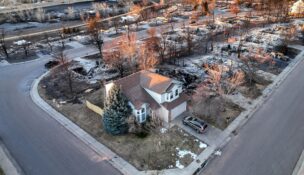Who owns Colorado: After the storm
David Lewis //June 1, 2011//
Social Darwinism – survival of the fittest and all that – is way out of fashion these days and pretty well totally un-PC, but folks who follow Colorado homebuilders still find good reason to turn to the Great Man for explanation.
No, we do not refer to his famous quotation that, “It is not the strongest of the species that survives, nor the most intelligent that survives. It is the one that is the most adaptable to change,” which it appears Charles Darwin never said anyhow.
We refer to his scientifically irrefutable statement that, “An American monkey, after getting drunk on brandy, would never touch it again, and thus is much wiser than most men.”
Actually both quotes help explain homebuilders today, especially independent homebuilders.
We Darwinians are pleased to be able to report that we have changed our classification of Colorado’s homebuilders, upgrading the status of the relatively few of them remaining in business to “threatened” from our earlier assessment of them as “endangered.”
“We peaked out in the mid-2000s at about 200 houses a year; last year we placed about 40,” says Gene Myers, CEO of Denver-based New Town Builders. “We’ve certainly not been immune to the greater forces of the market.”
The important point, though, is that New Town Builders survived to build another day.
“To put it into perspective, the average year for Denver over the last 10 years has been about 17,000 starts, and we did under 4,000 starts last year. That’s a dramatic shrinking of the market,” Myers says.
Even congenitally optimistic real estate pros, builders included, have been tested by this lingering downturn.
The housing recession “has been almost as hard on us as it has been on anybody else,” says Michael Hart, co-owner and sales and marketing vice president of Westminster-based Wonderland Homes. “I say, ‘almost,’ because a number of companies haven’t survived. We have.”
Staying in the black as you steer your business through the economic Storm of the Century is no mean feat.
“Our starts and closings were relatively flat last year; however, we were able to grow our revenue by 14 percent through a shift in the mix of product that we sold,” says Matt Mandino, president of giant Bloomfield Hills, Mich.-based PulteGroup Inc.’s Colorado division.
“Additionally, we saw a benefit from placing a greater emphasis on selling the options that our customers desired to have in their homes. This approach, along with careful management of our overheads, allowed us to be profitable in 2010,” which in general describes the tactics that most small homebuilders adopted, too.
If staying in or near profitability is a meaningful accomplishment for a division of a multibillion-dollar business like PulteGroup, think what it requires from a small independent homebuilder. It sure helps if your business is low on debt and exceptionally nimble.
{pagebreak:Page 1}
“We’ve managed to stay in the black, although barely at times, and we have managed to keep our company going, although we’re significantly smaller than we were, for example, at the end of 2006,” says Hart. “Our staff is about a third of the size that it was in 2006; our revenues are down by probably even a greater margin than that. We sold roughly 200 homes in 2006 and we closed 42 in 2010. Revenues and the number of sales are way, way down. But we’ve been able to keep it together and keep things going throughout the downturn.”
New Town Builders’ Myers echoes that assessment.
“We cut back, and I think we cut back before many of our peers,” he says. “It was just a necessity for us sooner than some of the other builders, but in the end it helped us. Nobody in our industry has gotten through this without pain. I do feel that the death of the independent builder has been predicted for many years – and it is more difficult now than ever.”
Unlike the Pultes and MDC Holdings of the world, independents are without access to Wall Street, for good or ill.
“The larger builder is able to buy in bulk and negotiate contracts with their suppliers and subcontractors, and they are able to borrow money at a much lower rate, which also makes it really hard for the little guys,” says Mike Rinner, executive vice president of Englewood-based residential real estate consultants the Genesis Group.
Thanks in large part to tightened bank regulations, independent homebuilders fear ending up without access to Main Street, too.
“It’s really two-faceted. The big public companies have access to debt capital that we don’t have,” Myers says. “And in particular our fate is intertwined with that of community banks, the small banks that lend to builders like us. And probably because we have this codependency, maybe that’s why they’re in trouble and we’re in trouble at the same time.”
Paring to the bone is one-half of the survivor’s formula. The other is entrepreneurial creativity.
New Town Builders offers a solar system and an array of green technologies built into its homes. With bank lending problematic, the company also has creatively sought private funding. Both New Town and Wonderland Homes praise their participation in the Stapleton Denver development as a kind of godsend. Other independents, such as Longmont-based Cornerstone Homes, cultivate greenness as well as higher income brackets.
Then there’s the tale of Louisville-based McStain Enterprises.
“Eco-builder McStain files for bankruptcy protection,” headlined the Denver Post in May 2009, reflecting the surprise of many when the high-visibility green builder filed for Chapter 11 bankruptcy reorganization.
In December 2009, Colorado Bankruptcy Court chief judge Howard Tallman agreed to the filers’ request to dismiss the case.
In April 2010, Tom and Caroline Hoyt, the former owners of McStain Enterprises, combined with Littleton-based International Risk Group and another investor to form MC3 Holdings LLC, doing business as McStain Neighborhoods.
“We were very transparent in what we were trying to do. Why did we have to end up in bankruptcy? We were caught with a couple of projects that we were overleveraged on. Since we were an incorporated company, unlike the LLCs of the world, unfortunately, it brought down the mother ship,” says MC3 president David Ware.
“During that time we said, ‘There’s brand value to “McStain Neighborhoods,” and what the founding members have done over the last 45 years. Let’s recapitalize ourselves here and start a new entity, MC3 Holdings LLC, which bought the license and trademark rights from the old McStain Enterprises Inc. And now we’re doing business as McStain Neighborhoods.”
So how’s it going?
“It’s going pretty good. The housing market obviously is in recovery. Will it ever recover to levels we saw, or is that healthy, is a whole separate debate,” Ware says. “It’s a challenge day-to-day for a private builder in the marketplace today, trying to raise capital and other things. But we’re moving the endeavor forward based on the brand strength McStain was known in the marketplace for.”
The independent builder’s motto today might be, “We’re still here.”
“It’s not because we’re so much smarter than everybody else that we’re still here, but we’ve made some very prudent decisions, so we’re still in business,” says Wonderland Homes’ Hart. “And we’re looking forward to things getting better.
“As bad as people say it is, the people still in the business are generally pretty optimistic. They always are, and they always sense that, ‘Next time we’re going to do better,’ and that kind of thing.”
{pagebreak:Page 2}






















